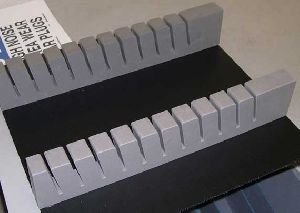
Epe Foam Fitment
Custom-fitting Fabricated Packaging For High Value Items Produced In Limited Volumes. Eliminates Cost Of Making Expensive Moulds. More Economical Than Using Eps In Many Cases. Can Be Tailored To Match The Shape, Size Or Profile Of Any Product - By Using A Simple Hot Air Gun And Knife. Provides Excellent Cushioning Against Shocks, Vibrations, Abrasions. Non-toxic. Resistant To Fungi, Bacteria & Chemicals. Combines Resilience With Flexibility. Requires No Special Expertise To Fabricate Or Use. Used By Automobile Industries For Seats Electronic Industries : Used As Fitments For Printers, computers, Engineering Industries handicraft Furniture, Medical Equipments, artillery Box Etc. • Technical Specifications given above indicate attritubutes of the product and are given in good faith and can vary depending upon climate and test conditions • Technical Specifications are subject to change without prior notice.
...more
Crosslink Polyethylene Fabrication foam
Cross-linked polyethylene foam is a closed-cell foam characterized by a compact feel and resistance to water. It is also ozone resistant and has many of the same properties as polyethylene foam but also has the ability to protect class "A" surfaces. It has higher tensile and tear strengths, and is thermo and vacuumformable which eliminate abrasion. Many of these foams are compatible with and are consequently used extensively in the packaging of food and medical products as well as equipment. Compression molding and thermoforming are common fabricating methods used when creating components, packaging and products from cross-linked polyethylene foams. Crosslinking improves the resilience, elasticity, and temperature stability that allows the material to be used in a wider range of temperatures (-100 degrees F to +180 degrees F). These fabrication methods provide a unique finish that is aesthetically pleasing while still providing the necessary cushioning and support required. These foams are available in a variety of colors, densities from 2-15 pounds per cubic foot, and thicknesses from 3/32" to 9" thick. Special additives, such as EVA improves softness, and FR meets UL94HFI. Crosslinking Polyethylene Foam enables it to be used for applications are not normally associated with P.E. foams. Foam Applications: Medical Applications Floatation Devices Toys Foam Tapes Gaskets & Seals Consumer Products Decorative Packaging Automotive Trunk and Head Liners Camping and Exercise Mats
...more
Crosslink Foam
Cross-linked polyethylene foam is a closed-cell foam characterized by a compact feel and resistance to water. It is also ozone resistant and has many of the same properties as polyethylene foam but also has the ability to protect class "A" surfaces. It has higher tensile and tear strengths, and is thermo and vacuumformable which eliminate abrasion. Many of these foams are compatible with and are consequently used extensively in the packaging of food and medical products as well as equipment. Compression molding and thermoforming are common fabricating methods used when creating components, packaging and products from cross-linked polyethylene foams. Crosslinking improves the resilience, elasticity, and temperature stability that allows the material to be used in a wider range of temperatures (-100 degrees F to +180 degrees F). These fabrication methods provide a unique finish that is aesthetically pleasing while still providing the necessary cushioning and support required. These foams are available in a variety of colors, densities from 2-15 pounds per cubic foot, and thicknesses from 3/32" to 9" thick. Special additives, such as EVA improves softness, and FR meets UL94HFI. Crosslinking Polyethylene Foam enables it to be used for applications are not normally associated with P.E. foams. Foam Applications: Medical Applications Floatation Devices Toys Foam Tapes Gaskets & Seals Consumer Products Decorative Packaging Automotive Trunk and Head Liners Camping and Exercise Mats
...moreBe first to Rate
Rate ThisOpening Hours